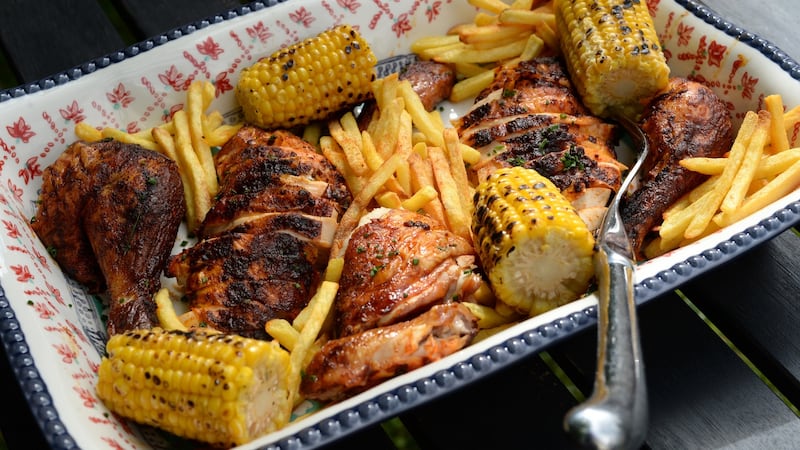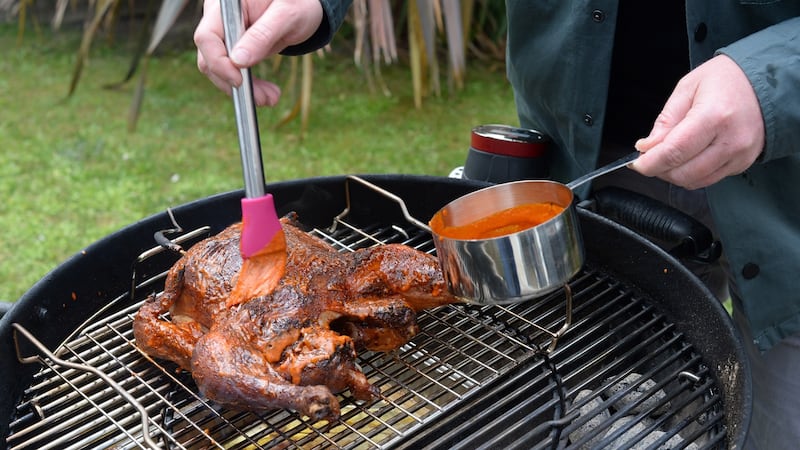There has always been a great rush to the Irish summer. We have to do things quickly, whether it’s trips to the beach, swimming or picnics. Often, it’s as many of these things as possible in a single day. The summer doesn’t last long and the weather betrays us frequently. We have to pack it all into a short space of time.
This might be especially true of barbecuing. It can so often be a mad scramble to dig the grill out of the shed, buy charcoal and grab whatever packaged meat is being flogged in the supermarkets. I like to think that it’s a chain reaction started by the first person on the street to light their barbecue. It’s a smell that makes me simultaneously hungry and jealous when I catch it wafting from a neighbour’s garden.
To be fair, these days it’s unusual for me not to be barbecuing, and I no longer wait for a sunny day to do it. It’s now an essential part of the weekly routine and as the weekends approach, I watch the weather forecast like a hawk to give me an idea of what might be possible. It could be a quick cook such as lamb kebabs, grilled hot and fast straight over the coals. It might be a duck on the rotisserie, the meat basting in its own fat and the skin puffing and drying until it’s mouth-wateringly crisp. Or my own preference: a large cut like brisket or pork shoulder, smoked low and slow for more than 10 hours, the exterior smoky and bark-like with the meat moist beneath.
I’m not a recent convert to barbecuing; it’s always been something I’ve enjoyed doing and for which I could claim a respectable enough proficiency. The first lockdown gave me an opportunity to push beyond that. Many hours and days were given over to smoking large cuts of meat, fiddling with vents, temperature probes and worrying about the dreaded “stall”. It became a highlight of the week when so many of the things I enjoy were off limits.

There is something about cooking outdoors that I find very satisfying, almost soothing, and I relish it, even on cold days. In fact, it was on those cold, dark days of winter that I probably took most pleasure from being outside and cooking something special. And I do believe that the food we cook outside is special.
There is a reason that most cultures have traditions of cooking over open fires or coals – traditions that endure to this day. Let’s bypass the weird trope that it’s down to some ethereal connection that men have to their caveman ancestors, who poked at pieces of meat burning in their fires.
We can write this off as an unhelpful macho stereotype. We’re still cooking this way because it tastes good. Food cooked over fire tastes good, meat flavoured with woodsmoke tastes good, the splash and sizzle of fat dripping on to hot coals makes food taste good. Or, at least, it should. If it’s done properly. The perception of barbecue might be that it’s rough and ready, a rustic way of cooking, but at its best there is a precision and elegance to it. It’s a science, an art.
I’m aware of the risk of sounding like a snob when I talk about barbecuing. Firstly, I’ve nothing but encouragement for anyone who wants to cook outdoors, however they do it. Grilling doesn’t have to be complicated, it can be tremendous when it’s kept simple.
We might have a tendency here to overcomplicate it by trying to cook too many things at the same time; burgers, sausages, chicken. That’s great when everybody enjoys it, but there’s a lot to be said for doing one thing very well and making some great side dishes to go with it, especially when you have guests. A butterflied leg of lamb, sizzled directly over the coals, is an excellent showstopper and very forgiving to novice grillers.
Sometimes it’s about marginal gains but small things can make a big difference. I’d advise anyone looking to expand their repertoire to invest in a digital thermometer with probes. If you’re spending good money on quality meat, you want it to be as close to perfect as possible. If you master the temperature of the grill and nail the temperature of your meat, success will follow. Second to the thermometer, a charcoal chimney starter will be a game-changing purchase – you’ll have your grill lit sooner and there’ll be no messing around with nasty lighter fluid.
I’m cooking on a very basic kettle-style barbecue. It didn’t cost the earth and is incredibly versatile. I’ve already had more than my money’s worth out of it but I suspect that our journey together will be a long one – and we’re only just getting started.
Conor Wilson is a reporter for Prime Time on RTÉ.

Conor Wilson's piri-piri chicken
This is something I’m asked to make at home a lot, particularly by my teenage daughter. I’ve tried many different methods and this is the one I’ve settled on as delivering the best possible outcome. I can’t vouch for its authenticity but it’s vibrant in both colour and flavour.
There are a million ways of doing chicken on the barbecue but I’m a stickler when it comes to chicken skin – it has to be crisp. In this case, the chicken will benefit from a little TLC. You could put it directly over the coals but the skin has a tendency to stick to the grates and any flare-ups can leave it sooty, which is unpleasant.
This recipe gives the chicken the best chance possible to develop that crispy skin, before applying the piri-piri sauce as a finish. I feel like you really get the best of both worlds this way. Spatchcocking the chicken lets it cook evenly and quickly.

You don’t need me to tell you that a few chips on the side will go very well, as well as chargrilled corn on the cob, but I also like to serve it with a crisp lettuce like Cos or Baby Gem. With a creamy dressing, it’s a cool and welcome contrast with the fiery piri-piri.
Ingredients
1 large chicken, about 2kg, spatchcocked
2 tsps salt
½ tsp baking powder
Piri-piri rub:
2 tsps paprika
1 tsp cayenne pepper
1 tsp brown sugar
1 tsp ground ginger
1 tsp ground coriander
Seeds from three cardamom pods
Piri-piri sauce:
3 tsp paprika
3 birds eye chilli (you can add more or less, depending on how hot you like it)
3 cloves garlic
Juice of 1 lemon
Glug of white wine vinegar
3 tbsps olive oil
Pinch of salt
Method
1 Arrange your spatchcocked chicken, skin side up, on a wire rack. Pat the skin dry with kitchen paper and sprinkle the salt and baking powder over the top of the skin. Pop into the fridge for at least an hour but preferably overnight. The salt will penetrate the meat and help to flavour it while drawing moisture away from the surface of the skin. This is really going to help it crisp up while cooking.
2 Set your barbecue up with two zones for indirect cooking. Bank your coals on one side, taking up about a third of the space (you can use a couple of foil-wrapped bricks to keep them in place), leaving the other two-thirds empty. I use a full chimney of fully lit charcoal. Put your grill grate in place and close the lid of your barbecue to let it heat it up properly. You're aiming for a temperature of between 180 and 200 degrees on the indirect side.
3 While your grill is heating up, bash the dry rub ingredients together in a pestle and mortar before sprinkling over the top of the chicken. You want a nice even layer of rub but you don't need to go too heavy or use all of the rub. Using a shaker will make this easier.
4 When your grill has come to temperature, place the chicken on the indirect side, with the legs facing the coals. If it fits, you can take the rack that you had the chicken on in the fridge and just put it on to the grates with the chicken still on it. It will make it easier to lift it off, or if you'd like to turn it at any point. At this stage, I like to throw a chunk of smoking wood on top of the coals. Close your lid and let it do its thing.
5 Put the piri-piri sauce ingredients into a mug or beaker just large enough to accommodate the head of an immersion blender. Lower the blender in and blitz until the ingredients combine into a thick emulsion. It should turn a fearsome orange colour. Reserve half of the sauce for serving at the table.
6 The chicken will probably take 45 minutes to an hour, but it could take longer. The only way to be sure is to check the temperature. Use a digital food thermometer. The chicken will be done when it hits 74 degrees in the thickest part of the breast and thighs. At this point, you could serve it as is. The skin should be nice and crisp with a beautiful burnished colour, but it will be even better with the sauce applied.
7 For the last few minutes of cooking, liberally brush the chicken with the piri-piri sauce. Close the lid and give the sauce a few minutes to cook into the chicken.
8 Allow the bird to rest before separating the thighs, drumsticks and wings. Slice the breasts across their width to ensure that every piece has some of that beautiful skin.












